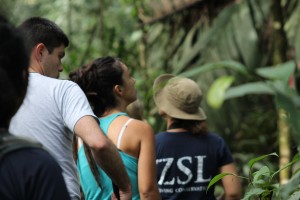
The thought of being away from home for over a month was pretty daunting. The week before I left was a whirlwind of arrangements at work and home, so much so that I didn’t have much time to even think about the adventure I was about to embark on. With a backpack stuffed with essential items (such as quick drying clothes, binoculars, rain boots and a head torch) I boarded the first of many flights to arrive 48hrs later in San José, Costa Rica.
The breakfast table at Gaudy’s Backpackers was abuzz with foreign accents and excited conversations between tired eyes and happy smiles before we all jumped in a minibus for the get-to-know-you ride to Tortuguero. The biological station we were going to call home for the next month was only accessible by boat, and so started the first of many rainy boat rides.
Reality finally set in when we arrived at Caño Palma Biological Station. Small wooden buildings on stilts in the midst of the jungle, with spider monkeys, green iguanas, toucans, deadly snakes and awesome gigantic spiders! We were all totally in our element.

Morning wake-up calls were compliments of the howler monkeys, which apparently get pretty ticked off when it’s about to rain, and they make sure you know about it. Breakfast was pretty chilled and there was always much needed coffee on tap. The kitchen is the social space of the station. In a mixed bag of languages and cultures, we all found our place and shared many stories over lunch and dinner (which was always plentiful and delicious!).

This year’s EDGE Fellows reign from Costa Rica, Philippines, Kenya, South Africa, Trinidad, Argentina and Mexico. Soon we were like a tight-knit multi-cultural family, arguing over whether Argentinians or Trinidadians are more laid back when it comes to punctuality, or whether Mexicans or Argentinians speak better Spanish… come to think of it, the “Argies” were involved in a lot of these debates! I’m going to blame it on the high caffeine content of the “Yerba Mate” they drink obsessively.
But we didn’t just eat and have heated discussions we also spent a LOT of time in the classroom. After all, this was a training course and the ZSL EGDE staff took it upon themselves to ensure we were armed with all the tools and knowledge we needed to be successful and effective conservation biologists. Sometimes this meant spending 8 hours a day doing statistics, or GIS mapping under the watchful eye of our teachers. We also covered data collection, social science and project planning.
At times it was really difficult, especially when all you want to do is go and explore in the jungle! But we learnt so much. We got to do some pretty cool field work too, including setting Sherman traps, camera traps and walking many a transect looking for snakes, amphibians, mammals and birds – and boy did we see some beauties! When animals were located we were trained in handling and ecological monitoring techniques and for me that was the highlight of the course. Well, that and the awesome basilisk lizards running on water! Other highlights included retrieving camera traps in waist deep water when the jungle flooded, and swapping stories with other visitors, volunteers and biologists at the station.
All in all the course has left us educated, informed and incredibly inspired. We are ready to take on our individual EDGE projects and save the world one EDGE species at a time!
By Mea Trenor, Mistbelt chirping frog EDGE Fellow
